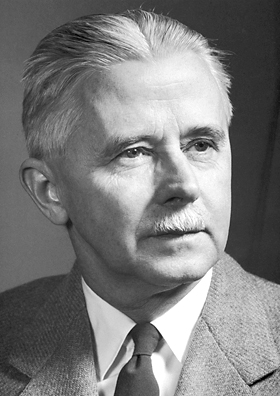Haldan Keffer Hartline facts for kids
Quick facts for kids
Haldan Keffer Hartline
|
|
|---|---|

Haldan Keffer Hartline, circa 1958
|
|
| Born | December 22, 1903 |
| Died | March 17, 1983 (aged 79) |
| Nationality | American |
| Alma mater |
|
| Known for | Visual perception |
| Awards |
|
| Scientific career | |
| Fields | Physiology |
| Institutions |
|
| Doctoral advisor | August Herman Pfund |
Haldan Keffer Hartline (December 22, 1903 – March 17, 1983) was an American scientist who studied how our bodies work, especially how we see. He was a physiologist. In 1967, he won the Nobel Prize in Physiology or Medicine. He shared this award with two other scientists, George Wald and Ragnar Granit. They all won for their amazing discoveries about how our eyes and brains work together to help us see.
Contents
Becoming a Scientist: Haldan Hartline's Education
Haldan Hartline started his college studies at Lafayette College in Pennsylvania. He finished there in 1923. After that, he went to Johns Hopkins School of Medicine. This is where he began to study the electrical signals in the retina, which is the back part of your eye that senses light. He earned his medical degree in 1927.
Haldan Hartline's Career and Research on Vision
After his studies, Hartline traveled to Germany to learn more. He then came back to the US and worked at the University of Pennsylvania. Later, he taught at Cornell Medical College in New York City. In 1949, he became a professor at Johns Hopkins School of Medicine. One of his students there, Paul Greengard, also went on to win a Nobel Prize! In 1953, Hartline joined Rockefeller University in New York City.
How Hartline Studied Vision
Haldan Hartline wanted to understand how vision works. He knew that human eyes are very complex. So, he decided to study the eyes of simpler animals. He looked at the eyes of arthropods (like insects), vertebrates (like fish), and mollusks (like snails).
He spent a lot of time studying the eye of the horseshoe crab (Limulus polyphemus). This animal has a much simpler eye than humans.
Discovering How Eyes Send Signals
Hartline used tiny tools called electrodes. These tools helped him record the electrical signals sent by a single nerve fiber in the horseshoe crab's eye. This was the first time anyone had recorded these signals! He found that when light hit one part of the eye, it sent an electrical message.
He also discovered something very important called lateral inhibition. This means that when one part of the eye is stimulated by light, the parts next to it become less active. This "turning down" of nearby areas helps the eye see sharper images. It makes the edges of objects stand out more clearly.
Thanks to Hartline's work, we now understand much better how individual light-sensing cells and nerve fibers in the eye work. His discoveries showed how simple parts of the eye help us put together all the visual information we see.
Awards and Honors for His Discoveries
Haldan Hartline received many important awards for his scientific work.
- In 1948, he became a member of the United States National Academy of Sciences.
- He was also elected to the American Philosophical Society in 1952.
- In 1957, he joined the American Academy of Arts and Sciences.
- He became a Foreign Member of the Royal Society (ForMemRS) in 1966.
- The biggest award came in 1967 when he won the Nobel Prize in Physiology or Medicine.
Personal Life
Haldan Hartline married Elizabeth Kraus Hartline in 1936. They had three children together.
See also
 In Spanish: Haldan Keffer Hartline para niños
In Spanish: Haldan Keffer Hartline para niños

